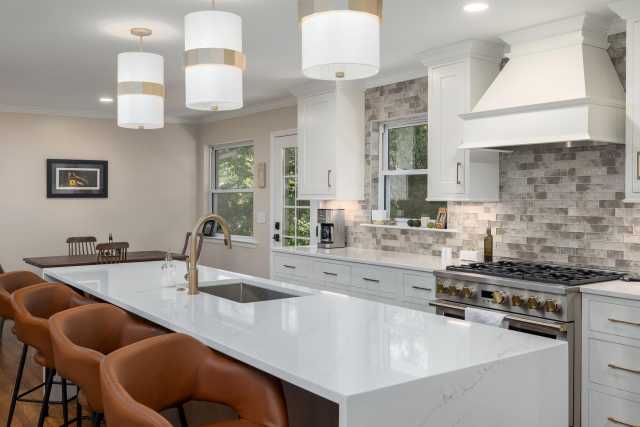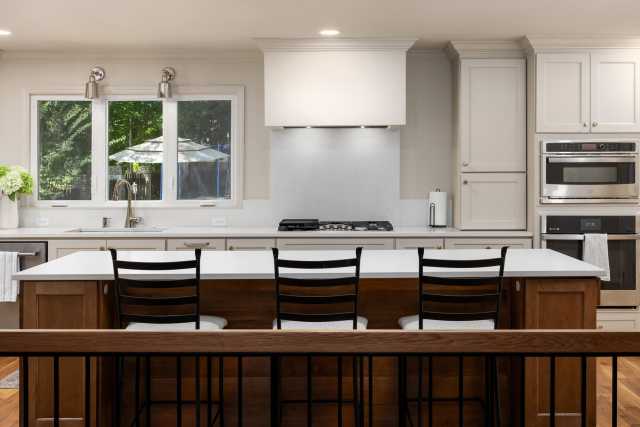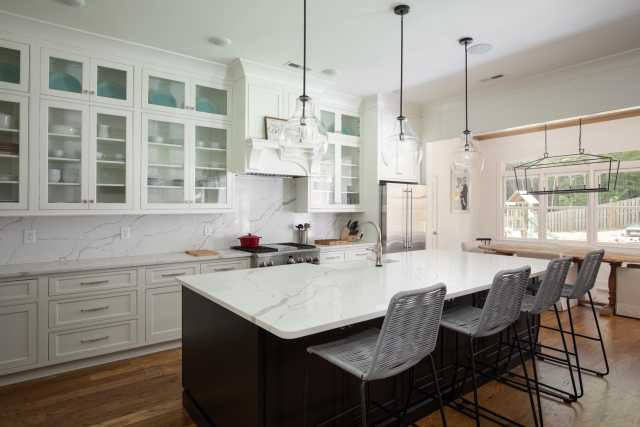The Culinary Stage: A Comprehensive Guide to Designing the Perfect Residential Chef's Kitchen - Part 3

The Workspace - Selecting Surfaces for Performance, Durability, and Style
The surfaces in a chef's kitchen are the tactile interface for culinary creation. They must be relentlessly durable, impeccably hygienic, and aesthetically pleasing. The selection of countertops, flooring, and backsplashes involves a careful balancing of performance characteristics, maintenance requirements, and personal style.
The Countertop Conundrum: A Material Deep Dive
Countertops are the primary stage for all prep work and must withstand sharp knives, hot pans, and acidic spills. The choice of material is not merely aesthetic; it can define the functionality of different work zones. A sophisticated design might even employ multiple countertop materials, optimizing each surface for its specific task. For example, a section of stainless steel next to the range for heat resistance, a large butcher block on the island for chopping, and a cool marble slab in a dedicated baking zone for rolling pastry.
|
Material |
Durability |
Heat Resistance |
Stain Resistance |
Maintenance |
Hygiene (Porosity) |
Cost (per sq. ft. installed) |
|
Quartz |
High (Mohs 7). Resistant to scratches & chips. |
Good, but can be damaged by extreme heat. |
Excellent. |
Low. No sealing required. |
Non-Porous. |
$75 - $200 |
|
Granite |
High (Mohs 6-7). Very durable. |
Excellent. Can place hot pans directly on surface. |
Good, but porous and can stain if not sealed. |
Medium. Requires periodic sealing (every 12-18 months). |
Porous. |
$70 - $175 |
|
Sintered Stone |
Very High. Resistant to scratches, chips, chemicals. |
Excellent. Withstands very high temperatures. |
Excellent. |
Low. No sealing required. |
Non-Porous. |
High (more costly than quartz) |
|
Stainless Steel |
Good. Can scratch and dent. |
Excellent. Impervious to heat. |
Excellent. Impervious to stains. |
Medium. Shows fingerprints; requires regular cleaning. |
Non-Porous, Highly Hygienic. |
$80 - $225 |
|
Butcher Block |
Medium. Prone to dents and scratches. |
Poor. Sensitive to heat. |
Fair. Can stain if not properly maintained. |
High. Requires regular oiling. Can be sanded to repair. |
Porous. |
$30 - $100 |
|
Concrete |
High. Very strong but can crack. |
Good. Heat-resistant. |
Fair. Can stain if not properly sealed. |
Medium. Requires sealing every 1-3 years. |
Porous. |
$65 - $135 |
Flooring Under Fire: Balancing Durability, Safety, and Comfort
A chef can spend many hours standing, so the kitchen floor must be more than just durable—it must also be safe and comfortable. This presents a critical trade-off: the hardest, most durable materials are often the most unforgiving on the body, while softer, more comfortable materials may require more maintenance or have a shorter lifespan. The ideal choice depends on the user's personal priorities, but a hybrid approach—using a highly durable material in high-traffic zones and a more comfortable material or anti-fatigue mats in primary standing areas—can offer the best of both worlds.
|
Flooring Material |
Durability & Scratch Resistance |
Water Resistance |
Comfort Underfoot |
Maintenance |
Relative Cost |
|
Porcelain Tile |
Excellent. Highly resistant to scratches, chips, and stains. |
Excellent. Waterproof. |
Low. Very hard surface. |
Low. Easy to clean and sanitize. |
$$ |
|
Engineered Hardwood |
Good. Varies by wood species and finish. |
Good. Water-resistant but not waterproof. |
Medium. More forgiving than tile. |
Medium. Requires specific cleaners. |
$$$ |
|
Luxury Vinyl Plank (LVP) |
Excellent. Highly resistant to dents and scratches. |
Excellent. Waterproof. |
High. Often has attached cork underlayment for warmth and cushioning. |
Low. Very easy to clean. |
$$ |
|
Cork |
Good. Naturally springs back from dents. |
Good. Naturally water- and stain-resistant; should be sealed. |
High. Very comfortable and provides sound reduction. |
Medium. Can be refinished. |
$$$ |
|
Natural Stone |
Excellent. Very tough and durable. |
Good. Porous and requires periodic sealing to resist stains. |
Low. Very hard surface. |
Medium. Requires sealing and pH-neutral cleaners. |
$$$$ |
The Backsplash: Where Function Meets Focal Point
The backsplash serves the dual purpose of protecting the walls behind the cooktop and sink from heat, grease, and water, while also acting as a primary aesthetic element in the kitchen. In a chef's kitchen, material choice should prioritize ease of cleaning.
- Slab Backsplash: For the ultimate in hygiene and a seamless, modern look, using a single slab of the same material as the countertop (such as quartz, granite, or sintered stone) is a popular high-end choice. This eliminates grout lines, which can trap grease and grime, making cleanup effortless.
- Tile: Tile offers endless design possibilities. Classic ceramic subway tiles are a timeless and affordable option. Glass tiles reflect light, making the kitchen feel brighter and more spacious. For a touch of drama, geometric patterns like hexagons or chevrons can create a stunning feature wall.
- Metal: A stainless steel backsplash, especially behind the range, offers an industrial, professional look and is unmatched for heat resistance and ease of cleaning. Warmer metals like copper or brass can add a luxurious, trendy touch, though they require more maintenance to prevent tarnishing.
- Exposed Brick: For a rustic or industrial aesthetic, an exposed brick backsplash adds texture and character. It must be properly sealed to protect it from grease and stains.
A growing trend is the full-height backsplash, where the chosen material extends from the countertop all the way to the ceiling or the bottom of the upper cabinets. This creates a bold, cohesive statement and maximizes the protected wall surface.





